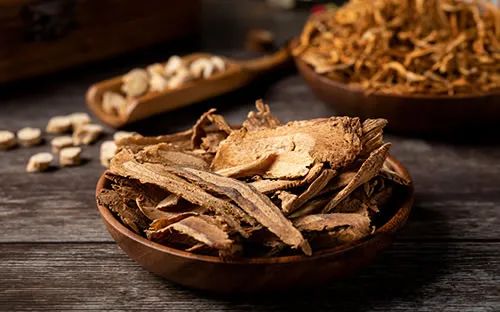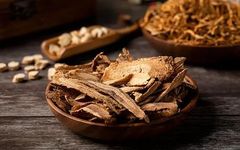Angelica Sinensis (Dong Quai), a traditional Chinese medicine, is the dried root of the plant from the Apiaceae family. It is known for its abilities to nourish blood, invigorate circulation, regulate menstruation, relieve pain, and promote bowel movements. It is commonly used for conditions such as blood deficiency, dizziness, palpitations, irregular menstruation, dysmenorrhea, abdominal pain due to cold, rheumatic pain, injuries, abscesses, and constipation.

Also known as Gan Gui, Ma Wei Dong Quai, Qin Gui, etc.
Kingdom: Plantae
Phylum: Angiosperms
Flavor: Sweet, Spicy; Nature: Warm
Class: Eudicots
Order: Apiales
Introduction to Angelica Sinensis
Angelica Sinensis is the root of the plant from the Apiaceae family, primarily used as a medicinal herb. It is also referred to as Gan Gui, Ma Wei Dong Quai, Qin Gui, etc.
Pharmacological Research on Angelica Sinensis
In traditional Chinese medicine, Angelica Sinensis is often prepared as slices or powder, or made into formulas such as Angelica Sinensis powder, soup, or pills. Modern medicine has utilized scientific technology to extract its active components for use in proprietary Chinese medicines, such as Angelica Sinensis blood-nourishing oral liquid and granules, making its effective ingredients more easily absorbed by the body.
Origin of Angelica Sinensis
Angelica Sinensis is primarily produced in the southeastern part of Gansu Province, particularly in Min County, known for its high quality and yield. It is also cultivated in provinces such as Yunnan, Sichuan, Shaanxi, and Hubei.
Efficacy and Uses of Angelica Sinensis
Benefits of Drinking Angelica Sinensis Water
Drinking water infused with Angelica Sinensis can inhibit the activity of Escherichia coli and diphtheria bacillus, providing antibacterial and anti-inflammatory effects. Its benefits also include preventing thrombosis and anemia, as it promotes the production of hemoglobin and increases the coagulation time of plasma in the body. Additionally, drinking water infused with Angelica Sinensis and Astragalus (Huang Qi) can replenish qi, nourish blood, invigorate circulation, and enhance immunity.
Benefits of Soaking Feet in Angelica Sinensis
Soaking feet in Angelica Sinensis can help dispel cold and invigorate circulation. In the cold winter months, soaking feet in water boiled with Angelica Sinensis can alleviate rheumatic pain and prevent frostbite. Furthermore, it can also help eliminate foot odor.
Contraindications and Side Effects of Angelica Sinensis
Unsuitable Populations for Angelica Sinensis
Individuals with excessive menstrual flow, bleeding tendencies, diarrhea, inflammation, and pregnant women should avoid using Angelica Sinensis.
Foods to Avoid with Angelica Sinensis
It is not advisable to combine it with antihypertensive medications to prevent orthostatic hypotension. It should also not be taken with aspirin, as it may increase the risk of bleeding.
Side Effects of Angelica Sinensis
Using Angelica Sinensis within normal dosage does not typically cause significant discomfort. However, excessive or prolonged use may lead to fever, headache, and decreased blood pressure, with severe cases potentially resulting in shock.
Price of Angelica Sinensis
The price of Angelica Sinensis is not particularly high; sliced Angelica Sinensis typically costs around 80-100 yuan per pound. When purchasing, one should choose those with a strong aroma, oily texture, yellow-brown skin, plump flesh, and a yellow-white cross-section.
How to Consume Angelica Sinensis Effectively
Angelica Sinensis Stewed with Chicken
Preparation: Clean and cut black-boned chicken into pieces, wash Angelica Sinensis and Astragalus, and place them in a clay pot with an appropriate amount of water. Simmer until cooked. Season to taste.
Benefits: Nourishes both qi and blood, strengthens the kidneys, and regulates essence.
Angelica Sinensis Boiled with Eggs
Preparation: Add three bowls of water to Angelica Sinensis, place boiled and shelled eggs with several small holes poked in them, and boil until the liquid reduces to one bowl.
Benefits: Nourishes qi and blood, regulates menstruation.
Angelica Sinensis Sweet Soup with Red Dates and Eggs
Preparation: Soak Angelica Sinensis, Huang Qi, and red dates in clean water for a few minutes, then place them in a clay pot with an appropriate amount of water. Bring to a boil, then simmer for 20 minutes. Add boiled and shelled eggs and cook for another 15 minutes, then add brown sugar to taste.
Benefits: Nourishes blood, invigorates circulation, regulates menstruation, and relieves pain.
Angelica Sinensis Ginger Lamb Soup
Preparation: Place Angelica Sinensis and ginger slices in a cloth bag, cut lamb into small pieces and blanch. Place the bag in a pot, add an appropriate amount of water, and simmer to extract the medicinal juice. Add the blanched lamb, bring to a boil, season with a little salt, and garnish with chopped green onions.
Benefits: Warms the center, replenishes deficiency, dispels cold, and relieves pain.
Formulas Containing Angelica Sinensis
Angelica Sinensis Four Reverse Decoction
Ingredients: Angelica Sinensis, Cinnamon Twig (Gui Zhi), Peony (Shao Yao), Asarum (Xi Xin), Tongcao, Licorice (Gan Cao), Jujube (Da Zao).
Preparation: Combine the seven ingredients with eight liters of water, boil to obtain three liters, and strain. Take one liter warm, three times a day.
Benefits: Warms the meridians, disperses cold, nourishes blood, and opens the vessels.
Source: Shang Han Lun
Angelica Sinensis Blood-Nourishing Decoction
Ingredients: Astragalus, Angelica Sinensis.
Preparation: Use two cups of water, decoct until one cup remains, strain, and take warm on an empty stomach.
Benefits: Nourishes qi and generates blood.
Source: Nei Wai Shang Bian Huo Lun
Angelica Sinensis Pain Relief Decoction
Ingredients: Qiang Huo, Licorice, Yin Chen, Fang Feng, Cang Zhu, Angelica Sinensis, Zhi Mu, Zhu Ling, Ze Xie, Sheng Ma, Bai Zhu, Huang Qin, Ge Gen, Ren Shen, Ku Shen.
Preparation: Grind to a powder, each dose 30g, with two and a half cups of water. Moisten with water, wait a moment, then decoct until one cup remains, strain, and take warm.
Benefits: Promotes diuresis, clears heat, dispels wind, and relieves pain.
Source: Yi Xue Qi Yuan
Angelica Sinensis Ku Shen Pill
Ingredients: Angelica Sinensis, Fritillaria, Ku Shen.
Preparation: Grind the ingredients into a powder, mix with honey to form pills the size of small beans. Take 3-10 pills, twice daily, with rice soup.
Benefits: Nourishes blood, moistens dryness, clears heat, and eliminates dampness.
Source: Jin Gui Yao Lue
Angelica Sinensis Aloe Vera Pill
Ingredients: Angelica Sinensis, Aloe Vera, Mu Xiang, Musk, Huang Bai, Huang Qin, Huang Lian, Da Huang, Zhi Zi, Qing Dai, Long Dan Cao.
Preparation: Take with ginger soup.
Benefits: Clears heat and dispels liver fire.
Source: Shi Fang Ge Guo
Angelica Sinensis Peony Powder
Ingredients: Angelica Sinensis, Peony, Poria, Bai Zhu, Ze Xie, Chuan Xiong.
Preparation: Grind into powder. Each dose is a thumb-sized spoon, mixed with wine, taken three times a day.
Benefits: Nourishes blood, regulates the liver, strengthens the spleen, and promotes diuresis.
Source: Jin Gui Yao Lue
Note from the Editor: The compatibility of traditional Chinese medicine emphasizes the importance of targeted treatment. Therefore, it is best to consult a professional TCM practitioner for proper formulation, rather than relying on online medication advice to avoid health risks.
How to Store Angelica Sinensis
It is recommended to store Angelica Sinensis in a dry, sealed container, keeping it in a cool, dry place to prevent moisture and pests. If it is processed into Angelica Sinensis charcoal, care should be taken to prevent re-ignition during storage.
Preparation Methods for Angelica Sinensis
1. Whole Angelica Sinensis
Remove impurities, wash, slightly moisten, slice thinly, and dry in the sun or at low temperatures. Sift out debris.
2. Angelica Sinensis Head
Clean the Angelica Sinensis, wash, slightly moisten, cut off 4-6 thin slices from the head, and dry in the sun or at low temperatures. Sift out debris.
3. Angelica Sinensis Body
Remove impurities, wash, moisten thoroughly, remove fibrous roots, slice the main root, and dry in the sun or at low temperatures. Sift out debris.
4. Angelica Sinensis Tail
Remove impurities, wash, moisten thoroughly, slice the fibrous root part, and dry in the sun or at low temperatures.
Preparation Method for Wine-Processed Angelica Sinensis
Take Angelica Sinensis slices, mix with a specified amount of yellow wine, slightly moisten, and after the wine is absorbed, place in a frying container and heat gently until deep yellow. Cool down. Use 10 kg of yellow wine for every 100 kg of Angelica Sinensis slices.
Preparation Method for Angelica Sinensis Charcoal
Place Angelica Sinensis slices in a frying container, heat over medium heat until the surface is slightly blackened, then cool down.
How to Cultivate Angelica Sinensis
Site Selection and Preparation
Angelica Sinensis prefers fertile, loose, and well-drained humus soil. After selecting the site, deep plow and rake the soil, apply base fertilizer, and create raised beds and drainage ditches.
Sowing Method
Mix Angelica Sinensis seeds with ash and sprinkle them on the bed surface, lightly press down, cover with a small amount of fine moist soil, and cover with straw to ensure light penetration and moisture retention.
Cultivation Management
1. Seedling Management
Keep the soil moist after sowing to facilitate seed germination. After about 40 days, loosen the covering straw. When seedlings are about 3 cm tall, loosen the soil once and remove weeds. After the hot season, remove the covering straw on a cloudy day.
2. Thinning and Supplementing Seedlings
Normally, about 20 days after transplanting, when seedlings are uniform, thinning and supplementing should be done, preferably on rainy days with seedlings transplanted with soil. After about 3 months, retain one healthy seedling per hole, removing diseased or weak ones.
3. Cultivation and Weeding
In mid-May, perform the first weeding, preferably shallow to avoid burying seedlings. In mid-June, perform the second weeding, which can be deeper to promote root development.

